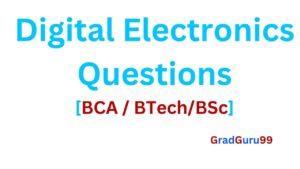Dear Readers! In this post, we present a set of selected questions on Digital System Design (DSD) for BTech students. Students of Computer Science, Electronics, and IT will find it useful if they solve the questions given here.
Digital System Design Questions for BTech Students
- What are BCD and Excess-3 codes?
- Subtract 1101 from 1000 using 2’s complement method.
- What is a full adder? Design a full adder circuit using two half-adders and one OR gate.
- Explain the difference between a decoder and a de-multiplexer.
- What is the toggling state and race condition in flip-flop?
- Draw the logic circuit of a master-slave JK flip-flop.
- Explain the encoder (ex. octal to the binary encoder) with a proper diagram and truth table.
- How does a priority encoder differ from an ordinary encoder? Draw the logic diagram of a 4-to-2
priority encoder. - Minimize the SOP expression given below using a K-map and implement the circuit using basic gates. Y=
Σm(1,3,7,11,15) + Σd(0,2,5,8,14). - Minimize the SOP expression given below using a K-map and implement the circuit using the NAND gate.
Y= Σm(1,3,4,5,9, 10, 11) + Σd(6,8). - Design a full adder using 4:1 MUX only.
- Design a full adder using a 3-to-8-line decoder and a suitable logic gate.
- With logic diagram and the truth table explain the working of the JK flip-flop. Also, obtain its characteristic equation.
- Realize J-K flip-flop using S-R flip-flop.
- Write the excitation table of SR and JK flip flop.
- Design a mod-5 ripple Counter using the J-K flip-flop.
- Draw the logic diagram of a 4-bit parallel adder. Mention the drawback of this circuit.
- Find out the difference between combinational logic circuits and sequential logic circuits.
- Explain the limitations of half subtractor over full subtractor.
- Explain SR flip flop in detail (diagram & truth table). What is the disadvantage of it and how it can be eliminated?
- What is a multiplexer? Explain 4X1 multiplexer.
- Design a 3to 8 line decoder using two 2to 4 line decoder.
- What do you mean by serial shifting? Explain the difference between PISO and PIPO.
- Explain the operation of the Jhonson ring counter (Twisted ring counter).
- What is a CLA adder (fast adder)? Define the terms ‘carry generate’ and ‘carry propagate’.
- Give the classification of semiconductor memories.
- What do you mean by FPGA? Name some manufacturers of FPGA.
- What is the difference between a level-triggered and edge-triggered flip-flop?
- What is a latch? Find the difference between a latch and a flip-flop.
- What is the function of PRESET and CLEAR input of a flip flop?
- Implement EX-OR gate using the minimum number of NAND gates.
- Write the De-Morgan’s theorem.
- What are the differences between synchronous and asynchronous counters?
- Draw the circuit diagram of a 4-bit ring counter. Write the output sequences.
- Find the difference between SRAM and DRAM.
- Find the difference between ROM, PAL, and PLA (these are examples of programmable logic devices)
- Explain the operation of the Successive approximation type A to D converter.
- What is the role of the sample and hold circuit in the A to D converter?
- Draw the CMOS NOT, NAND, and NOR circuits.
- What is HDL and what is its application? What are the different models used in HDL?



![Read more about the article Digital Electronics semester paper 2023-2024 for MAKAUT BCA students [PDF download]](https://gradguru99.com/wp-content/uploads/2024/02/digital-electronics-23-24-makaut-bca-sem-Q-300x169.jpg)